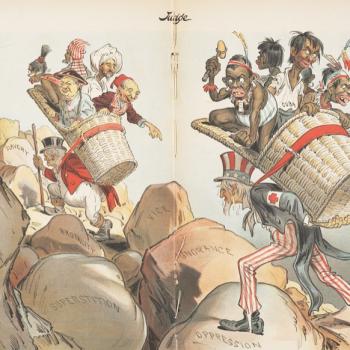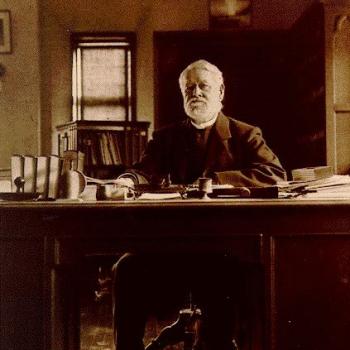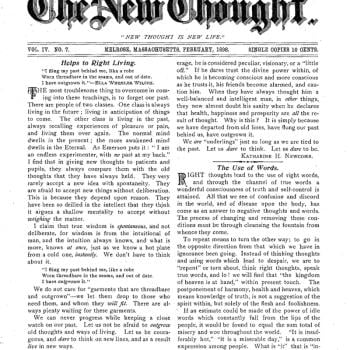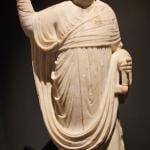I have been spending a lot of time recently with the apocryphal texts of the Old Testament, the pseudepigrapha. This material can become obsessive!
Through much of Christian history, the relationship between Old and New Testaments was very different from how most would imagine it today. Modern believers certainly see foretastes or prophecies of Christ in the Old, but on a very minor scale compared to anything understood by earlier generations. In early and medieval times, Christians found countless symbolic representations of Christ throughout the Old Testament, to the point that those stories merged seamlessly into the New, creating a single expanded gospel. While incorporating the narrative of Christ’s life and mission, this combined text places it absolutely in a sequence of stories that runs from Adam through the patriarchs and prophets.
As an example, I cite the once-famous Book of the Bee, composed in 1220 by Bishop Solomon of Basra, in what is now Iraq. Solomon was a bishop of the ancient Church of the East, the so-called Nestorians, and he draws on long centuries of Syriac learning. The Book of the Bee is a classic salvation history, describing the Old and New Testaments, but with all sorts of unsuspected (and improbable) connections. Typology runs riot.
Let me give a couple of examples, out of a great many. We know, for instance, that Moses had a rod, which appears several times in the canonical text. In one miracle, it transforms into a serpent. But where did this rod come from? Solomon knows:
WHEN Adam and Eve went forth from Paradise, Adam, as if knowing that he was never to return to his place, cut off a branch from the tree of good and evil–which is the fig-tree–and took it with him and went forth; and it served him as a staff all the days of his life. After the death of Adam, his son Seth took it, for there were no weapons as yet at that time. This rod was passed on from hand to hand unto Noah, and from Noah to Shem; and it was handed down from Shem to Abraham as a blessed thing from the Paradise of God. With this rod Abraham broke the images and graven idols which his father made, and therefore God said to him, ‘Get thee out of thy father’s house,’ etc. It was in his hand in every country as far as Egypt, and from Egypt to Palestine. Afterwards Isaac took it, and (it was handed down) from Isaac to Jacob; with it he fed the flocks of Laban the Aramean in Paddan Aram. After Jacob, Judah his fourth son took it; and this is the rod which Judah gave to Tamar his daughter-in-law, with his signet ring and his napkin, as the hire for what he had done. From him (it came) to Pharez. At that time there were wars everywhere, and an angel took the rod, and laid it in the Cave of Treasures in the mount of Moab, until Midian was built. There was in Midian a man, upright and righteous before God, whose name was [Jethro]. When he was feeding his flock on the mountain, he found the cave and took the rod by divine agency; and with it he fed his sheep until his old age. When he gave his daughter to Moses, he said to him, ‘Go in, my son, take the rod, and go forth to thy flock.’
We then move on to the well-known Biblical story of Moses, who deploys the rod passed on to him from the Garden of Eden.
So where does Christ come into this? Well, when Solomon describes the crucifixion, he explains the detailed Old Testament connections, back to Moses and beyond:
Some men have a tradition that the stone that was laid upon the grave of our Lord was the stone that poured out water for the children of Israel in the wilderness. The grave in which our Redeemer was laid was prepared for Joshua the son of Nun, and was carefully guarded by the Divine will for the burial of our Lord. The purple which they put on our Lord mockingly, was given in a present to the Maccabees by the emperors of the Greeks; and they handed it over to the priests for dressing the temple … As to the tree upon which our Redeemer was crucified, some have said that He was crucified upon those bars with which they carried the ark of the covenant; and others that it was upon the wood of the tree on which Abraham offered up the ram as an offering instead of Isaac. His hands were nailed upon the wood of the fig-tree of which Adam ate, and behold, we have mentioned its history with that of Moses’ rod.
I could go on at much greater length.
This seems fantastic, but it has a deadly serious point. Solomon is showing that in every sense, Christ was the culmination of the Old Testament narrative. In this story, Christ is the point and the rationale – truly the Alpha and Omega.
Modern readers need a real effort of will to appreciate the mind-set behind such writing. But appreciating it opens our eyes to the radically different thought-world of the Christian Middle Ages.












